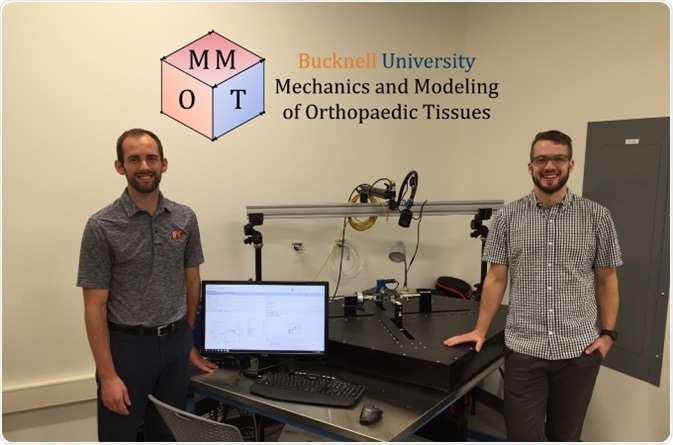Sponsored Content by ADMETOct 29 2019
The Mechanical and Chemical Engineering departments at Bucknell University utilize the ADMET eXpert 8000 Planar Biaxial testing system supplied with MTESTQuattro and an environmental bath.

Image Credit: Bucknell MMOT Lab
The primary aim of the University’s investigations is to better understand the structure-function mechanisms in biological soft tissues, specifically orthopedic tissues. A further goal is to produce and design tissue replacements.
Research
Benjamin Wheatley, PhD, the Principal Investigator of Bucknell University Mechanics and Modeling of Orthopedic Tissues Laboratory, and his colleague Kenny Mineart, PhD, collaborated with ADMET to discover an effective testing solution to assist in their research. They were looking for an instrument that would be able to:
- Analyze a wide range of loads, from low (< 1N) to mid (~ 1 kN), along with applying biaxial loading
- Stretch samples to high strain (particular polymeric gels continue to be elastic in excess of 1000% uniaxial strain).
Dr. Wheatley’s research centers on the simulation and characterization of the mechanical function of orthopedic tissues. These are complicated soft tissues that are saturated with fluids and are fiber-reinforced.
Modeling techniques and mechanical investigations offer an enhanced understanding of how these tissues function within the body, how impairment and diseases are correlated, and how clinical treatments can be created.
The laboratory emphasizes skeletal muscle and its macro to micro-level deformation.
Questions to be investigated include: When skeletal muscle is deformed (for example in stretching), how do the tissue components deform? How is the organization and content of skeletal muscle related to stiffness, especially in impaired tissues?
Within the tissue, how does fluid flow? This information can assist in shaping the wider clinical and engineering approaches. Click below to view the laboratory website.
Dr. Mineart’s laboratory produces structure-function relationships in unique polymer gels, particularly in physically-crosslinked gels.
These polymeric gels are very tunable regarding their mechanical response such as viscoelasticity and modulus. They are ideal candidates for various uses because of this, including orthopedic tissue replacement.
Biaxial loading of the polymeric gels from the laboratory obtains the required data for more complex and relevant deformations, allowing Dr. Mineart and his group to understand their design gels and mechanical function better for its intended applications.
In a single day, these teams can evaluate a gel specimen that can stretch to 200+% equibiaxial strain, and then test highly soft tissues, for example, skeletal muscle, and lastly assess stiffer tissues such as tendon.
The investigators valued the robustness of the system the most, and this is what the ADMET system was able to offer.
Dr. Wheatley explained, “The ability to do all of the above is important to us. We strongly value having a range of load and displacement capabilities, along with a state-of-the-art digital image correlation system.”
Here are some specific ways in which we use the data that we collect with the instrument:
- Correlate tissue structure to mechanics in orthopedic tissues
- Develop and validate computational models of orthopedic tissues
- Explore how polymeric gel formulation, and correspondingly nanostructure, affects gel mechanics.”
Equipment
The planar biaxial testing system employed by Bucknell University is an eXpert 8000 supplied with the MTESTQuattro software and controller.
The system was provided with several load cell capacities to enable a high range of loads. Every load cell is calibrated in line with ASTM E4 to establish +/-1% accuracy down to 0.5% of the capacity.
The test frame comprises an environmental bath with nickel-plated stainless steel grips, along with a recirculating assembly and heater.
ADMET’s video extensometer and digital image correlation system (in unison with MTESTQuattro) can be utilized for post-processing investigations.
For example, it can be used to calculate mean and standard deviation, minimum and maximum, stress-strain curve generation, time-slice extraction, data extraction along lines and more.
The user can acquire contactless and video-based strain data with modifiable extension ranges and gauge lengths. The operator can calculate single points or set several virtual extensometers.
The extensometer gives the user instant load data compared with strain data, along with real-time output to MTESTQuattro for servo control. The video extensometer can track instant data in both transverse and axial axis to offer data to calculate Poisson’s ratio.
The system includes algorithms to offer strain data and full-field displacement for the mechanical testing of planar specimens.
It can be utilized for material testing such as bi-axial tension tests, fracture mechanics, and FEA validation, for example strain localization around notches and cracks.
The DIC system and video extensometer comprise a high-resolution monochrome digital camera, mounts, lens,lighting, and all the necessary adapters and cables.
About ADMET
Richard Gedney, CEO and founder of ADMET, graduated from Northeastern University in Boston in 1986 with a degree in Mechanical Engineering. By 1988, he had graduated from MIT with a masters degree in mechanical engineering and by 1989 he had formed Advanced Machine Technology, later shortened to ADMET.
Sponsored Content Policy: News-Medical.net publishes articles and related content that may be derived from sources where we have existing commercial relationships, provided such content adds value to the core editorial ethos of News-Medical.Net which is to educate and inform site visitors interested in medical research, science, medical devices and treatments.